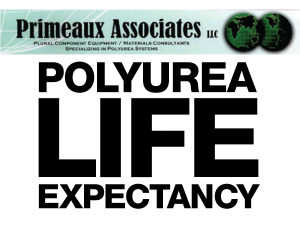Polyurea Life Expectancy Discussion

A question has recently been asked as to the life expectancy of a polyurea spray elastomer system as it relates to an application in an immersed saltwater environment. While this question is really not new to the technology, it seems that there has not been any published data or information to support any direct claims that may have been made. But we still would like to know, “How Long Will it Last”?
As you are aware, the polyurea spray elastomer technology is relatively new to the industry with respect to conventional polyurethane and epoxy type coating systems. Since the development in 1986 and first commercial use in 1988, true life history is only slightly over 15 years. This has provided somewhat of a “brick wall” if you will as to the real performance of the material. There is data and information available on the technology though that might suggest the long-term performance. This data includes accelerated testing on the technology compared to the basic physical properties.
The first most common testing with regard to accelerated exposure is weatherometer testing. During the development work on the polyurea technology at Texaco Chemical Company, several aromatic based polyurea systems were exposed to ASTM G 53 (Practice for Operating Light- and Water-Exposure Apparatus (Fluorescent UVCondensation Type) for Exposure of Nonmetallic Materials). This has commonly been referred to as accelerated weatherometer testing. The number of hours exposure can be extrapolated to years of outdoor service.
During that work, the aromatic systems were exposed to a total of 3800 hours, using the UVB-313 bulbs, 50°C. The type bulbs have been shown to give higher UV output, faster testing and improved uniformity in the test. After this exposure, the samples were retested and compared to the original physical property data. What was shown was that the physical property retention was at least 80% of the elastomer’s original physical property results. While the surface of the elastomer did show discoloration (yellowing) this was only at the surface. There was no chalking or cracking of the elastomer surface after exposure.
Discussion continues in full PDF.
Disclaimer: While the information presented is believed to be reliable and represents the best available data on this or these products, no guarantee, warranty, or representation is made, intended, or implied as to the correctness or sufficiency of any information as to the suitability for any chemical compound for any particular use. Primeaux Associates LLC makes no warranty and it is up to the individual user to determine suitability and use of the product.







